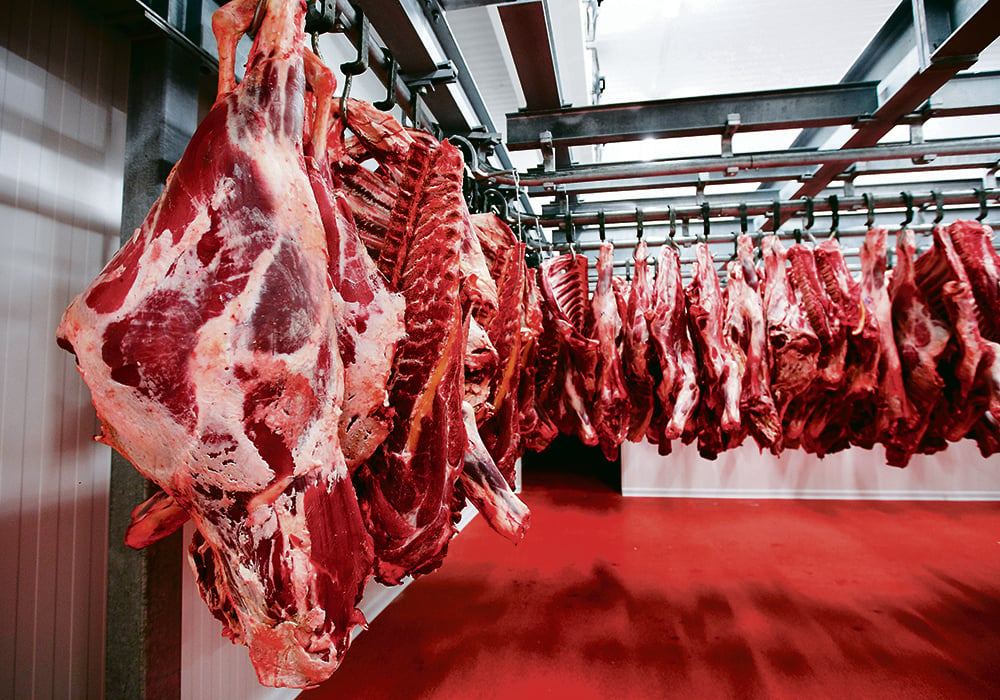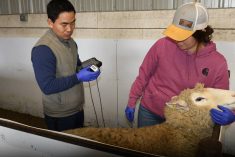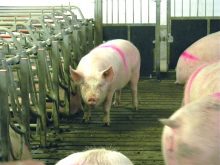Once commercialized, the high-tech meat management system promises gains on efficiency, sustainability, quality
Glacier FarmMedia – Artificial intelligence is digging footholds in agriculture and agribusiness, from crop and herd monitoring to traceability and weed management. For one Manitoba-born company, AI has become a tool for carcass quality control in the meat sector.
Cameron Bergen is chief executive officer and co-founder of mode40, a technology services company that helps manufacturing organizations update facilities with the latest technology. The company started in his basement in 2020, but today spans a 40-person engineering team that is expected to grow by 20 more people over the next few months.
One of its recent ventures uses the Internet of Things (IoT) — a term describing the interconnection between internet, computing devices in everyday objects and their ability to send and receive data — and AI to regulate meat processing temperatures. This enhances food safety and improves meat quality.
Read Also

Beef cattle more prone to trace mineral deficiencies
The trace mineral status of our cows and calves is a significant challenge for western Canadian producers and veterinarians.
Agriculture and agribusiness companies continue to find ways in which AI can bolster best practices and collect and use data.
The project’s official name is “Commercialization of IoT and AI for Carcass Cooling to Improve Meat Profitability, Quality and Food Safety.”
The meat quality management system is the first of its kind, according to Bergen. It leans on a collaboration between AI, mobile technology and smart sensors to make real-time adjustments to carcass cooling.
It gives primary processors access to data to make quick decisions on the temperature and conditioning of individual carcasses.
“There’s a lot of critical elements to the cooling process of carcasses, and (a lot of) those opportunities for negative quality outcomes,” Bergen said. “In order to prevent those outcomes, we knew that we needed some method of collecting that data and analyzing that data quickly.”
The sensors monitor temperature, humidity and wind speed, to name a few. Data is fed into a cloud system. Then the AI system uses the information to predict optimal cooling time for carcasses.
Bergen said he is using mode40 to show how applying the right technology can bring significant improvements to the agri-food industry, making it more competitive and sustainable.
The project garnered over $465,300 of its $1.3 million-plus price tag from the Canadian Agri-Food Automation and Intelligence Network (CAAIN). It came about in response to Innovation, Science and Economic Development Canada’s Innovative Solutions Canada Challenge.
The funding will allow mode40 to move the project from in-house lab development to pre-commercialization.
Once it has a minimal viable product — when it has enough features to take on early adopter customers — it will move to Agriculture and Agri-Food Canada’s larger Lacombe Research and Development Centre in Alberta. There, Bergen and his team will validate their technology in 10 commercial meat processing plants to gauge its success in saving money.
After evaluation and about three months of fine tuning, Bergen hopes the technology will be market-ready.
“Our goal is to bring this to a commercial state and have it be available to everyone in the market.”
A commercialized system could be ready by early 2026.
The ability to monitor, manage and control temperatures in food production improves health and safety, said Darrell Petras, CAAIN’s chief executive officer, in a May press release. The project will also improve quality, which will increase profitability.
“That’s a win for farmers, primary processors, and ultimately consumers,” Petras said. “There’s no question that the (money) we are investing out of project lead mode40’s total cost … is a sound investment that will be returned to taxpayers many times over financially, socially and environmentally.”
Petras said more people in the sector now realize that practical AI technology can help farmers and food processors in their every day operations.
“They’re no longer something only a PhD person can understand and use. They’ve been simplified in a way.”
AI technology can also reduce on-farm labour, he noted and agriculture’s labour gap is a pressing problem.
Bergen said adoption of innovative technology will help Canadian producers remain globally competitive. In the past, Canada hasn’t always made the most of opportunities to innovate, he said, and changing that will involve showing people how simple forms of data can be collected to unlock more value.
He hopes an “unparalleled shift” in technology use, profitability and improved efficiency will follow.
















